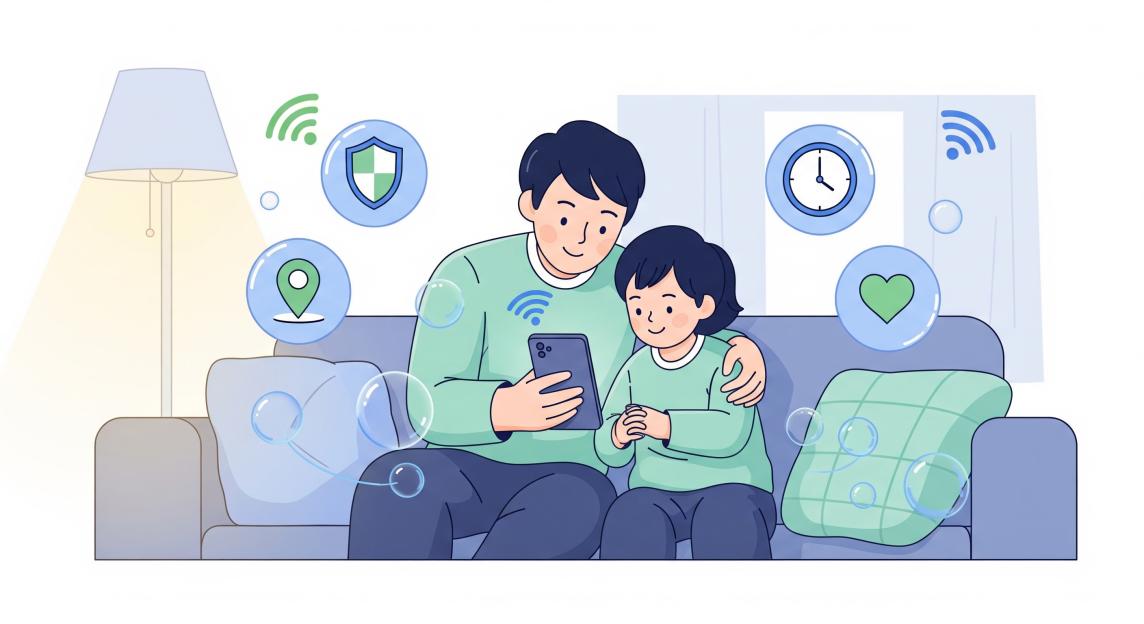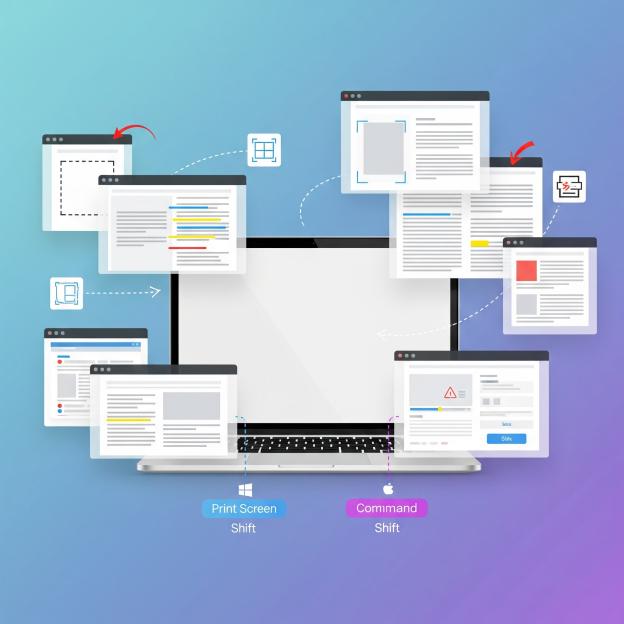That sinking feeling when your 12-year-old disappears into their room with their phone, and you hear nothing but silence for hours. The worry that creeps in when they’re out with friends and you can’t reach them.
The sleepless nights wondering what they’re seeing online, who they’re talking to, and whether they’re safe in the vast digital world that seems to grow more complex every day.
You’re not alone in these concerns. As parents in 2025, we’re navigating uncharted territory where our children are digital natives, often more tech-savvy than we are. The statistics are sobering: 95% of teens have access to a smartphone, and they spend an average of 7-9 hours daily on screens. With cyberbullying affecting 37% of children and online predators becoming increasingly sophisticated, the need for digital parenting tools has never been more critical.
This comprehensive guide will walk you through the best phone monitoring apps available today, helping you find the right balance between keeping your children safe and respecting their growing independence. We’ll explore features, compare costs, and provide practical advice for implementing these tools in a way that builds trust rather than destroys it.
Understanding the Need for Phone Monitoring Apps

The Digital Landscape Our Children Navigate
Today’s children face challenges that previous generations never encountered. Social media platforms, messaging apps, online gaming communities, and endless internet content create both opportunities and risks. According to recent studies, 42% of children have experienced cyberbullying, while 15% admit to bullying others online.
The risks extend beyond social interactions. Children can accidentally access inappropriate content, fall victim to online scams, or develop unhealthy screen time habits that affect their sleep, academic performance, and social development. Additionally, location safety has become a primary concern for parents, especially as children gain more independence.
Why Traditional Parenting Methods Aren’t Enough
Gone are the days when parents could simply monitor their child’s activities by checking their room or asking about their day. Digital interactions happen instantly, privately, and often in ways that leave no visible trace. Children can delete messages, use private browsing modes, and communicate through apps that parents have never heard of.
This isn’t about distrust – it’s about adapting our parenting strategies to match the technology our children use daily. Just as we childproof our homes and teach our kids about stranger danger, we need digital tools to help navigate online safety.
Building a Foundation of Trust
Before diving into specific apps, it’s crucial to understand that monitoring technology should complement, not replace, open communication with your children. The most effective approach combines monitoring tools with honest conversations about digital citizenship, online safety, and the reasons behind parental oversight.
Top Phone Monitoring Apps for Parents in 2025
1. Qustodio – The Comprehensive Solution
Rating: 4.8/5
Qustodio stands out as one of the most comprehensive parental control solutions available. Used by over 4 million families worldwide, it offers robust monitoring capabilities across multiple devices and platforms.
Key Features:
- Real-time location tracking with geofencing alerts
- App usage monitoring and time limits
- Web content filtering with customizable categories
- Social media monitoring for platforms like Instagram, Facebook, and YouTube
- Screen time management with detailed reports
- Call and SMS monitoring
- Panic button feature for emergencies
Pricing:
- Free plan: Basic monitoring for 1 device
- Small plan: $54.95/year for up to 5 devices
- Medium plan: $99.95/year for up to 10 devices
- Large plan: $137.95/year for up to 15 devices
Pros:
- User-friendly interface for both parents and children
- Excellent customer support
- Works across iOS, Android, Windows, and Mac
- Detailed activity reports
- No rooting or jailbreaking required
Cons:
- Advanced features require paid subscription
- Some social media monitoring limitations on iOS
- Occasional connectivity issues
2. Norton Family – Security Giant’s Parental Solution
Rating: 4.6/5
Norton Family leverages decades of cybersecurity expertise to provide comprehensive child protection. It’s particularly strong in web filtering and protection against online threats.
Key Features:
- Advanced web filtering with real-time threat detection
- Location tracking and check-in features
- Time supervision with flexible scheduling
- App monitoring and blocking
- Search supervision across major search engines
- Video supervision for YouTube content
- Instant lock feature for immediate device control
Pricing:
- Included free with Norton 360 Deluxe ($109.99/year)
- Standalone Norton Family: $49.99/year
Pros:
- Excellent web filtering capabilities
- Strong malware and threat protection
- Easy setup process
- Good integration with other Norton products
- Reliable location tracking
Cons:
- Limited social media monitoring
- Interface can be overwhelming for new users
- iOS functionality is more limited than Android
3. Bark – AI-Powered Content Monitoring
Rating: 4.7/5
Bark takes a unique approach by using artificial intelligence to monitor content rather than blocking everything. It analyzes communications for potential issues like cyberbullying, online predators, depression, and suicidal thoughts.
Key Features:
- AI-powered content analysis across 30+ platforms
- Email and text message monitoring
- Social media oversight (Instagram, Snapchat, TikTok, etc.)
- Screen time management
- Location tracking and alerts
- Web filtering with customizable settings
- Alerts for potential mental health concerns
Pricing:
- Bark Jr: $5/month (screen time and filtering only)
- Bark Premium: $14/month (full monitoring suite)
Pros:
- Advanced AI detection of concerning content
- Covers more platforms than most competitors
- Privacy-focused approach (monitors for issues, not every detail)
- Excellent mental health monitoring
- Works well with teens who have more privacy needs
Cons:
- More expensive than some alternatives
- Learning curve for understanding AI alerts
- Limited location tracking features
4. Screen Time (Apple’s Built-in Solution)
Rating: 4.3/5
For families using Apple devices, Screen Time offers a free, built-in parental control solution that integrates seamlessly with iOS and macOS.
Key Features:
- App usage limits and downtime scheduling
- Content and privacy restrictions
- Purchase and download controls
- Communication limits
- Real-time usage reports
- Family sharing integration
Pricing:
- Free (included with iOS 12+ and macOS Catalina+)
Pros:
- Completely free
- Perfect integration with Apple ecosystem
- Cannot be easily bypassed or uninstalled
- Simple, clean interface
- Regular updates from Apple
Cons:
- Only works with Apple devices
- Limited location tracking
- No web content monitoring
- Basic compared to dedicated apps
- No social media oversight
5. Google Family Link – Android’s Native Solution
Rating: 4.2/5
Google Family Link provides comprehensive parental controls for Android devices and Chromebooks, offering a free solution for Google-centric families.
Key Features:
- App approval and time limits
- Device location tracking
- Web content filtering
- Screen time management
- Device locking capabilities
- Activity reports
- Safe search enforcement
Pricing:
- Free
Pros:
- Completely free
- Excellent integration with Google services
- Good location tracking
- Simple setup process
- Regular feature updates
Cons:
- Limited to Google ecosystem
- Basic web filtering
- Children can request more time easily
- Limited social media monitoring
- Interface could be more intuitive
6. Mobicip – Budget-Friendly Comprehensive Monitoring
Rating: 4.4/5
Mobicip offers a good balance of features and affordability, making it an excellent choice for budget-conscious families who still want comprehensive monitoring.
Key Features:
- Web content filtering with 18 categories
- App blocking and time limits
- Location tracking with geofencing
- Screen time schedules
- Social media monitoring
- Usage reports and insights
- Remote device management
Pricing:
- Basic: $2.99/month
- Standard: $4.99/month
- Premium: $7.99/month
Pros:
- Very affordable pricing
- Good feature set for the price
- Works across multiple platforms
- Easy-to-use interface
- Good customer support
Cons:
- Less advanced than premium competitors
- Limited AI-powered features
- Occasional performance issues
- Basic reporting compared to higher-end options
7. Circle Home Plus – Network-Level Protection
Rating: 4.1/5
Circle Home Plus takes a different approach by monitoring and controlling internet usage at the network level, affecting all devices connected to your home Wi-Fi.
Key Features:
- Network-level filtering and controls
- Device-specific time limits
- Content filtering across all connected devices
- Usage history and insights
- Bedtime and pause features
- VPN protection when away from home
- Guest network controls
Pricing:
- Circle Home Plus device: $129.99 one-time
- Circle Premium service: $9.95/month
Pros:
- Controls all devices on network
- Cannot be easily bypassed
- Good for families with multiple devices
- VPN protection for mobile devices
- Simple setup process
Cons:
- Requires hardware purchase
- Monthly subscription for full features
- Limited individual device customization
- Can affect guest usage
- May slow internet speeds slightly
Essential Features to Look for in Monitoring Apps
Real-Time Location Tracking
Location tracking has become one of the most valued features among parents. Look for apps that offer:
- GPS accuracy: Real-time location updates with precise positioning
- Geofencing: Automatic alerts when children enter or leave designated areas
- Location history: Ability to view where your child has been throughout the day
- Safe zones: Custom areas like school, home, or friends’ houses
- Emergency features: Panic buttons or check-in capabilities
App and Web Content Monitoring
Comprehensive content monitoring should include:
- App usage tracking: See which apps are used most frequently and for how long
- Web filtering: Block inappropriate websites based on categories or specific URLs
- Search monitoring: Track what your children are searching for online
- Download controls: Approve or block app downloads and purchases
- Social media oversight: Monitor interactions on popular platforms
Screen Time Management
Effective screen time tools offer:
- Flexible scheduling: Different rules for weekdays, weekends, and holidays
- App-specific limits: Set different time limits for different types of apps
- Downtime features: Automatically lock devices during study time or bedtime
- Break reminders: Encourage healthy screen time habits
- Reward systems: Allow extra time for good behavior or completed chores
Communication Monitoring
For younger children or high-risk situations, consider:
- Text message monitoring: Review incoming and outgoing messages
- Call log tracking: See who your child is communicating with
- Email oversight: Monitor email communications
- Contact management: Control who can contact your child
- Keyword alerts: Get notified about concerning conversations
Privacy and Trust Considerations
When selecting monitoring software, balance safety with privacy:
- Age-appropriate monitoring: Adjust oversight levels based on your child’s maturity
- Transparency options: Choose apps that can notify children when monitoring is active
- Data security: Ensure the app company has strong data protection policies
- Graduated privacy: Plan to reduce monitoring as children demonstrate responsibility
Setting Up Phone Monitoring: Step-by-Step Guide
Before You Begin: Having the Conversation
The success of any monitoring system depends heavily on how you introduce it to your children. Here’s how to approach this sensitive conversation:
For Younger Children (Ages 8-12):
- Frame monitoring as a safety tool, like wearing a seatbelt
- Use simple analogies they can understand
- Focus on the protection aspect rather than surveillance
- Involve them in setting up some of the features
For Teenagers (Ages 13-18):
- Have an honest discussion about online risks and your concerns
- Explain that monitoring is temporary and will decrease as they demonstrate responsibility
- Involve them in choosing the app and setting initial rules
- Establish clear criteria for reducing monitoring over time
Installation Process
Step 1: Choose Your App Based on your family’s needs, device types, and budget, select the monitoring app that best fits your requirements.
Step 2: Create Parent and Child Accounts
- Download the app on your device first
- Create a parent account with a strong, unique password
- Set up child profiles for each device you’ll be monitoring
Step 3: Install on Child’s Device
- Download the app on your child’s device
- Log in with the child account credentials
- Grant necessary permissions (location, app usage, etc.)
- Test all features to ensure they’re working correctly
Step 4: Configure Settings
- Set up location tracking and geofences
- Configure web filtering based on your child’s age and maturity
- Establish screen time limits and schedules
- Set up alert preferences for different types of activities
Step 5: Test the System
- Verify that all monitoring features are working
- Test alert systems to ensure you receive notifications
- Check that your child can still use their device normally for approved activities
Customizing Settings by Age Group
Elementary Age (6-10 years):
- Strict web filtering with whitelist approach
- Limited app selection focused on educational content
- Early bedtime restrictions (7-8 PM)
- Constant location tracking
- Parent approval required for all downloads
Middle School (11-13 years):
- Moderate web filtering with category blocking
- Gradual introduction of social apps with heavy monitoring
- Bedtime restrictions around 9-10 PM
- Location tracking with some privacy zones
- Guided app exploration with parent oversight
High School (14-18 years):
- Balanced approach focusing on safety rather than control
- Limited social media monitoring focused on dangerous content
- Flexible screen time with study and sleep protections
- Location check-ins rather than constant tracking
- Increasing privacy with safety-focused oversight
Best Practices for Digital Parenting
Establishing Clear Rules and Expectations
Creating a family technology agreement helps set clear boundaries and expectations:
Device Usage Rules:
- Specific times when devices can and cannot be used
- Appropriate locations for device usage (no phones at dinner table)
- Consequences for misuse or breaking agreements
- Regular review and update of rules as children mature
Online Behavior Expectations:
- Treat others with respect and kindness online
- Never share personal information with strangers
- Report uncomfortable or concerning interactions immediately
- Ask permission before downloading new apps or creating accounts
Communication Guidelines:
- Regular check-ins about online experiences
- Open door policy for discussing digital concerns
- Family media literacy education
- Modeling good digital citizenship as parents
Building Digital Literacy
Teaching children to navigate the online world safely is just as important as monitoring their activities:
Critical Thinking Skills:
- How to identify reliable sources of information
- Understanding the difference between facts and opinions online
- Recognizing potential scams and fraudulent content
- Evaluating the credibility of social media posts and news articles
Privacy Awareness:
- Understanding how personal data is collected and used
- The importance of strong, unique passwords
- How to adjust privacy settings on social media platforms
- The permanence of digital footprints
Emotional Intelligence Online:
- Understanding how tone can be misinterpreted in text
- Recognizing and dealing with cyberbullying
- The importance of taking breaks from social media
- How to have respectful disagreements online
Gradual Independence and Trust Building
The ultimate goal of monitoring should be to raise children who can navigate the digital world safely and responsibly on their own:
Progressive Privacy:
- Start with comprehensive monitoring for younger children
- Gradually reduce oversight as children demonstrate good judgment
- Involve children in evaluating their own digital habits
- Celebrate responsible behavior with increased privileges
Trust Verification:
- Regular family discussions about online experiences
- Spot-checks to ensure continued good judgment
- Clear consequences for betraying trust
- Opportunities to earn back privileges after mistakes
Preparation for Independence:
- Teaching children to self-monitor their screen time
- Helping them develop healthy digital habits
- Discussing college and adult-level digital responsibilities
- Ensuring they understand online safety even without parental oversight
Addressing Common Concerns and Challenges
Privacy vs. Safety Balance
One of the biggest challenges parents face is finding the right balance between keeping children safe and respecting their privacy:
Age-Appropriate Monitoring:
- Comprehensive oversight for elementary-age children
- Focused safety monitoring for middle schoolers
- Trust-but-verify approach for high schoolers
- Clear criteria for reducing monitoring over time
Transparency Levels:
- Some parents prefer complete transparency about monitoring
- Others use more discreet monitoring to avoid behavior modification
- Consider your child’s personality and maturity level
- Be prepared to adjust your approach based on their response
Technical Challenges
Device Compatibility:
- Ensure your chosen app works with all family devices
- Consider mixed-platform families (iOS and Android)
- Plan for device upgrades and replacements
- Understand limitations of different operating systems
Bypass Attempts:
- Children may try to circumvent monitoring software
- Stay educated about common bypass methods
- Choose apps with robust protection against tampering
- Maintain open communication about why monitoring is important
Performance Impact:
- Some monitoring apps can slow down devices
- Monitor battery usage and performance
- Choose lightweight apps when possible
- Be prepared to adjust settings if performance issues arise
Legal and Ethical Considerations
Legal Rights:
- Parents generally have the legal right to monitor minor children’s devices
- Laws vary by state and country
- Consider local regulations about recording communications
- Understand your responsibilities regarding data discovered through monitoring
Ethical Implications:
- Consider the long-term impact on your relationship with your child
- Balance immediate safety concerns with trust building
- Respect your child’s developing autonomy
- Be prepared to justify your monitoring decisions
Cost Analysis and Budget Considerations
Free vs. Paid Solutions
Free Options:
- Apple Screen Time and Google Family Link offer basic monitoring
- Limited features but good for simple needs
- No ongoing costs but fewer capabilities
- Good starting point for families new to monitoring
Paid Solutions:
- More comprehensive features and better support
- Regular updates and new feature additions
- Better integration across multiple platforms
- Typically range from $3-15 per month
Total Cost of Ownership
When evaluating costs, consider:
Direct Costs:
- Monthly or annual subscription fees
- Hardware costs (like Circle Home Plus)
- Setup fees or activation costs
- Additional device fees
Indirect Costs:
- Time spent setting up and managing the system
- Potential device performance impacts
- Need for customer support or technical assistance
- Replacement costs if children damage devices in frustration
Value Assessment
To determine if a monitoring app is worth the cost:
Safety Benefits:
- Peace of mind for parents
- Early warning system for digital dangers
- Protection against cyberbullying and online predators
- Location safety and emergency features
Educational Value:
- Teaching children about digital citizenship
- Building awareness of screen time habits
- Encouraging responsible online behavior
- Providing data for family discussions about technology use
Long-term Investment:
- Building foundation for responsible adult technology use
- Preventing potentially costly consequences of risky online behavior
- Developing family communication patterns around technology
- Creating systems that can adapt as children grow
Future of Parental Control Technology
Emerging Trends
Artificial Intelligence Integration:
- More sophisticated content analysis
- Predictive monitoring based on behavior patterns
- Automated responses to concerning activities
- Personalized recommendations for family digital wellness
Mental Health Focus:
- Enhanced detection of depression, anxiety, and self-harm indicators
- Integration with mental health resources and professionals
- Positive reinforcement for healthy digital habits
- Stress and sleep impact monitoring
Privacy-First Approaches:
- End-to-end encryption while maintaining safety features
- Local processing to reduce data sharing
- User-controlled data retention and deletion
- Transparent data usage policies
Technology Adaptations
Platform Evolution:
- Monitoring apps adapting to new social media platforms
- Enhanced gaming and virtual reality oversight
- IoT device monitoring for smart homes
- Cross-platform integration improvements
Regulatory Changes:
- Potential government mandates for parental control features
- Privacy regulation impacts on monitoring capabilities
- Age verification requirements for social platforms
- Data protection enhancements
Making Your Decision: Choosing the Right App
Family Assessment Checklist
Before selecting a monitoring app, evaluate your family’s specific needs:
Device Ecosystem:
- What types of devices does your family use?
- Do you need cross-platform compatibility?
- How many devices need monitoring?
- What’s your technical comfort level?
Child Factors:
- Ages and maturity levels of your children
- Specific risk factors or concerns
- Your children’s comfort with technology
- Previous digital behavior and trustworthiness
Parent Factors:
- Your monitoring philosophy and approach
- Time available for system management
- Budget for monitoring solutions
- Desired level of detail in monitoring
Risk Assessment:
- Specific online dangers you’re most concerned about
- Your child’s exposure to risky situations
- Community and school digital environments
- Family history of online issues
Implementation Timeline
Week 1: Research and Selection
- Review family needs and preferences
- Research and compare different monitoring apps
- Read reviews and get recommendations from other parents
- Make final selection based on your assessment
Week 2: Setup and Configuration
- Purchase and download selected monitoring app
- Set up parent and child accounts
- Install on all relevant devices
- Configure initial settings and preferences
Week 3: Testing and Adjustment
- Test all monitoring features
- Adjust settings based on initial results
- Address any technical issues or concerns
- Fine-tune notification preferences
Week 4: Family Integration
- Have ongoing conversations about the monitoring system
- Adjust rules and expectations based on early experiences
- Address any resistance or concerns from children
- Establish routine for reviewing monitoring reports
Long-term Success Strategies
Regular Review and Adjustment:
- Monthly family meetings to discuss digital habits
- Quarterly review of monitoring settings and rules
- Annual assessment of monitoring needs and privacy levels
- Ongoing education about new digital trends and risks
Communication Maintenance:
- Keep conversations about digital safety ongoing
- Share interesting or concerning trends you notice
- Celebrate positive digital citizenship behaviors
- Address issues promptly and constructively
Flexibility and Adaptation:
- Be willing to adjust your approach based on results
- Consider your child’s developmental changes
- Stay informed about new technologies and risks
- Maintain focus on long-term relationship health
Conclusion: Balancing Safety, Trust, and Independence
Choosing to monitor your child’s phone is a significant decision that reflects the complex challenges of parenting in the digital age. The apps and strategies outlined in this guide provide powerful tools for keeping children safe online, but they’re most effective when used as part of a comprehensive approach to digital parenting.
Remember that monitoring technology is just one component of raising digitally responsible children. The conversations you have, the trust you build, and the values you model are equally important. The goal isn’t to control every aspect of your child’s digital life indefinitely, but to provide scaffolding and support as they develop the skills and judgment needed to navigate the online world safely and responsibly.
As you implement these tools, keep the long-term relationship with your child in mind. The monitoring you do today should contribute to raising an adult who makes good digital decisions not because they’re being watched, but because they understand the importance of digital citizenship and have developed healthy technology habits.
The digital landscape will continue to evolve, bringing new platforms, new risks, and new opportunities. By establishing good communication patterns and using monitoring tools thoughtfully, you’re preparing your family to adapt and thrive regardless of what technological changes the future may bring.
Start with open conversation, choose monitoring tools that fit your family’s values and needs, and remember that the ultimate goal is raising children who can navigate the digital world with confidence, wisdom, and integrity. The investment you make in digital parenting today will pay dividends in your child’s safety, success, and well-being for years to come.







